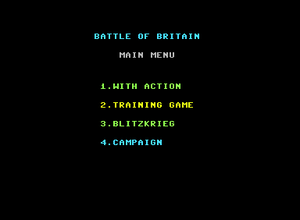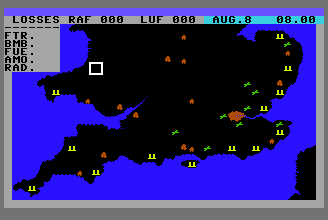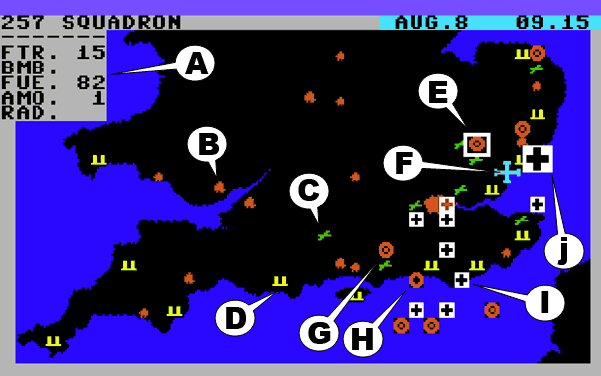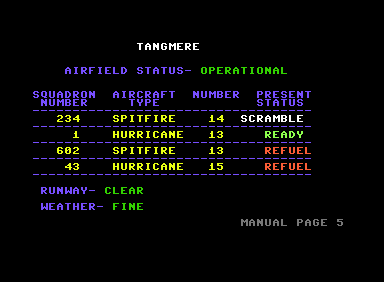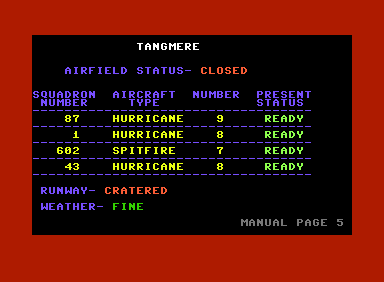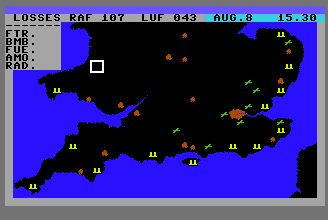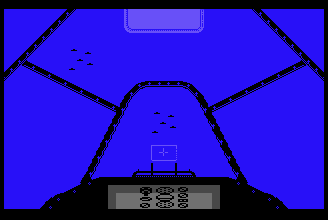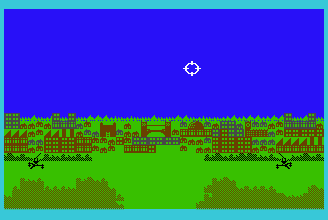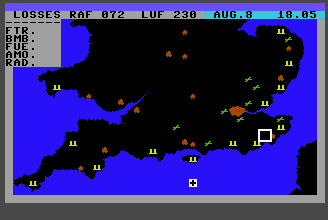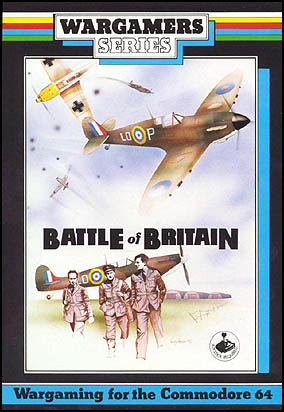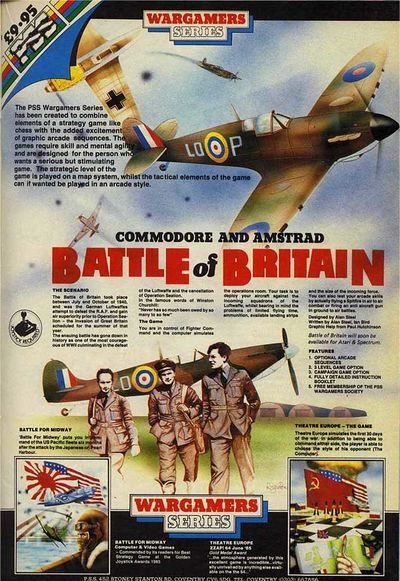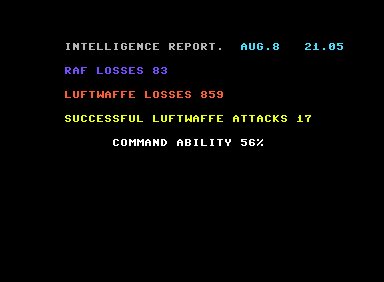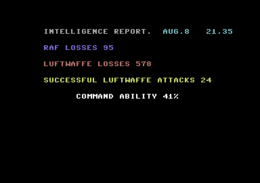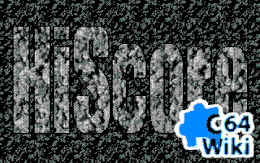Battle of Britain
| Battle of Britain | ||
|---|---|---|
| Game No. | 318 | |
| Voting | 6.46 points, 13 votes | |
| Company | Personal Software Services (PSS) | |
| Musician | Rob Hubbard | |
| HVSC-File | MUSICIANS/ H/ Hubbard_Rob/ Battle_of_Britain.sid | |
| Release | 1985 | |
| Platform | C64, ZX Spectrum, Amstrad | |
| Genre | Strategy, Shoot'em Up, War | |
| Gamemode | Single player | |
| Operation | ||
| Media | ||
| Language | ||
| Information | US version published by Firebird | |
Description[edit | edit source]
Battle of Britain is a strategy game with optional action sequences by Personal Software Services (PSS) from 1985, that picks up the topic of the Battle of Britain in World War II. As the leader of the Fighter Command of the Royal Air Force the player needs to fend off attacks of the German Luftwaffe onto English towns and radar devices.
The game offers three different levels:
- Training: A relatively calm day which is suited to practice the basic mechanisms of the game.
- Blitzkrieg: A massive attack, in which the enemy attacks with all available forces - the main thing is it has a propeller.
- Campaign: A campaign mode that streches over several weeks. At the end of each campaign day substitute pilots can be allocated to the harmed crew, which however on the long run leads to a lowering of the quality of the fighter corps. The campaign ends when the number of losses on one side is too high and you are either detached to the "Desert Rats" in Africa to chase camels (says the game) or the Luftwaffe is moved to the eastern front. The campaign can be saved after each day.
Furthermore you can choose whether you want to play with action intermissions. If you decide for them, you get the possibility to interfere with air fights and defence of the ground targets during the course of the game.
Strategical map[edit | edit source]
The heart of the game is a map of the South of England on which the own and the hostile units, as well as the strategic targets that need to be defended, are shown. The game takes place in real time but can be paused. Each game or campaign day starts at 8.00h and usually ends latest at 18.00h or when the last hostile unit has left the air space. The time passes with 5 minutes per 10 seconds real time. A whole party takes - with action scenes - about one hour in the "Blitzkrieg mode", without action scene about 15 minuts of real time.
Within a short time span the Luftwaffe alliances shown as Balkenkreuze appear at the border of the map and move towards their targets. Now the player has to choose an airfield with the cursor named "COMM BOX", to activate the fighter squadrons that are stationed there and intercept the enemy with them. If he does not succeed, the bombers will bomb the area allocated to them, which gives minus points in the final evaluation.
- A: Infobox, that shows the number of fighters (FTR), bombers (BMB), fuel reserve (FUE), ammunition (AMO) and the total number of machines in a hostile alliance (RAD).
- B: Town
- C: Airfield
- D: Radar device
- E: COMM-BOX to pick airfields and fighter squadrons
- F: Target of the fighter squadron currently chosen
- G: Fighter squadron of the RAF
- H: Fighter squadron of the RAF with low fuel reserves (black dot)
- I: Hostile alliance
- J: Big hostile alliance (more than 100 machines)
The Royal Air Force[edit | edit source]
The player has 18 fighter squadrons with each 15 Hurricanes or respectively Spitfires that are unregulary scattered over 9 airfields. So, e.g. the Manston Airfield in the uttermost south east is at the start of each game unoccupied.
The game does not differ between Hurricanes or Spitfires concerning their abilities, they are equal in all respects.
- Each airfield can keep a maximum of four squadrons at the same time. To let a squadron rise you choose the airfield and the desired unit, which is then started by pressing the fire button.
- While being in the airfield screen the time is stopped. To return to the map just move the joystick sideways.
- It takes some minutes before the squadrons are ready to use and during this time no other squadron can start.
- However, several units can land simultaneously on the same airfield, whereby not only the home airfield can be used but also a neighbouring airfield. Refuelling and refilling of ammuntion of landed units also takes its time.
- While a campaign is running all units are set back to their original airfields during the night.
- A fighter squadron will attack the first hostile alliance that it meets on its route allocated by the player.
- If the fuel of a squadron that is in the air is getting scarce, this will be announced by an acoustic signal, a message on the screen and a change in the crew's symbol. This unit must instantly be landed or it will be lost.
- Each squadron has only enough ammunition to get through one air fight, no matter how many (or few) enemies are in the hostile alliance. Also these used units should be landed as fast as possible or else they will be disabled.
- Airfields are after towns the preferred targets of the Luftwaffe. If it gets clear that an airfield is approached by a group of bombers, all - or at least the most intact - units should be started as fast as possible or you will suffer severe losses.
- Bomebd airfields are in the future shown as "damaged". Here starting and landing will take significantly longer. If there is a second bombing, the airfield is displayed as "cratered" and cannot be used any more. All crews that might still be stationed there drop out for the rest of the game or the next campaign day.
- Rain also delays the bustle. In the campaign mode also ground fog can appear which makes the airfield useable only during the course of the day.
The Luftwaffe[edit | edit source]
The Luftwaffe attacks with an overwhelming number, especially in the scenario "Blitzkrieg" the number of attackers can go up to over 1000 during the day. Mostly the alliances of bombers have fighter protection, but there are also single alliances of mere bombers. Each formation has exactly one fixed target, which it will try to reach on the shortest route as long as it still has at least one bomber. What this exactly is, cannot be found out beforehand. So if an alliance has taken its course on which there are several possible targets, so each of them can be the target or simply be flown over. However, sometimes the mission is easy to reognize, because there are no other targets in the chosen direction. If only one single bomber arrives at the target destinations, this means deduction of points for the player or repsectively a bombed airfield or a destroyed radar station (see below).
Although an alliance without any bomber will turn around, it will nevertheless be attacked automatically by fighter squadrons, that it meets on its way back. So the player has to take care that he does not waste his units on bomberless alliances and change the course if needed.
Radar[edit | edit source]
The radar stations scattered around the coasts are enormously useful to warn the player prematurely from new appearing enemies. As long as the hostile machines are still over the canal/the North Sea only their complete number is shown. The exact number of fighters and bombers can be seen only over the continent.
A radar stations bombed by the enemy (even if it is only one single bomber that has reached it) leaves a "blind spot" in the radar observation where no Luftwaffe information are shown any more. The activities only appear when the objects are over the English continent and this mostly comes surprisingly. By pressing the key R you see where the radar observation has any gaps.
Bombed radar stations are repaired in the campagin game, their loss is permanent in the scenarios.
Fortunately, the radar stations are the last concerning the Luftwaffe's priority after the towns and air fields.
Action sequences[edit | edit source]
If you have chosen a game with action sequences, you get the possiblity to gear into the events each time a fresh fighter squadron meets with a Luftwaffe alliance or when a bomber alliance attacks a town, an airfield or a radar station. Then either a symbol of an RAF squadron (air fight) or the Balkenkreuz symbol (flak) flashes, highlighted with a warning sound. The player then places the COMM-BOX on the desired symbol and the action sequence starts. Sometimes several sequences are triggered at the same time, the player then has to decide for one.
If no action sequences are chosen or the player decides "against" taking part in the action sequence by pressing the fire button, the computer calculates the loss rates which are mostly minimal on both sides.
Air fight
If it is a mixed Luftwaffe alliance (bombers with protection from fighters), the player has to decide first whether to take on the bombers or the fighters. The bombers are always at the lower right of the pulk, the fighters always at the top. The ammunition is only enough for a few seconds of permanent fire, so you should only shoot if you think you will hit. Each shot destroys as many hostile machines as you have fighters in your own squadron (so if you attack with 15 Hurricanes, then 15 hostile machines per hit are destroyed).
After some time there is the danger that you will be attacked from the back by a fighter, which can be seen in the rear mirror. You can only shake it off by shooting the machine before you as quickly as possible. If you take too long, the attack will end prematurely and fataly. The fuel supply of your own squadron additionally limits the attack.
Oh, and the instruments have absolute no meaning and are only "painted on".
Flak
During attacks on ground targets the player operates an antiaircraft gun and can try to shoot the attacking dive bombers and horizontal bombers with the finder sight. Depending on the number of the hostile bombers that are left, the sequence can take shorter or longer. In contrast to the air fight there is no danger for yourself.
To effectively fight the bombers, it is recommended to shoot with a slight allowance and let the machines fly into the cloud of shrapnel. With a bit of training you can get several fighters at once with this technique.
This sequence can be aborted at any time by pressing Space .
Design[edit | edit source]
The graphics are kept simple. Even in the action sequences the design is hardly more than "plain". That only a changed character set was used can be proved with Shift +Commodore . Battle of Britain consists to a certainly not little part of the good, old Basic.
To boost the troop's morale, the entertainer Rob Hubbard was engaged, who contributed a peculiar-happy combination of marching music, swing and sway song and spacy effect battle as title music.
Hints[edit | edit source]
Keys[edit | edit source]
- R : show gaps in the radar observation
- F1 : abort game
- P : Pause on/off
- Space : abort flak sequence
Squadron list[edit | edit source]
| Squad. | Type | Location | Squad. | Type | Location | |
|---|---|---|---|---|---|---|
| 234 | Spitfire | Middle Wallop | 501 | Hurricane | Biggin Hill | |
| 609 | Spitfire | Middle Wallop | 54 | Spitfire | Hornchurch | |
| 87 | Hurricane | Middle Wallop | 111 | Hurricane | Debden | |
| 213 | Hurricane | Middle Wallop | 257 | Hurricane | Debden | |
| 602 | Spitfire | Tangmere | 19 | Spitfire | Duxford | |
| 617 | Hurricane | Tangmere | 310 | Hurricane | Duxford | |
| 43 | Hurricane | Tangmere | 66 | Spitfire | Coltishall | |
| 1 | Hurricane | Northolt | 74 | Spitfire | Coltishall | |
| 79 | Hurricane | Biggin Hill | 242 | Hurricane | Coltishall |
Solution[edit | edit source]
- It is almost impossible to make the game without the action sequences, almost every hostile alliance will pass.
- In air fights, always attack the bombers at the lower right.
- Used squadrons should not be landed on airfields that lie on the path of newly approaching Luftwaffe units.
- Attack big formations of enemies only with intact crews, to minimize your losses.
- BUG: If you eliminate ALL hostile machines of a type (bomber or fighter) in the air fight, this can lead to wrong calculations of the losses, in the worst case the enemy does not lose any machines "at all".
Cheats[edit | edit source]
Nope, what helps here is "blood, sweat and tears!" ;)
Voting[edit | edit source]
| Voting of the C64-Wiki users (10=the best vote): | ||
| 6.46 points at 13 votes (rank 670). You need to be logged in to cast a vote. | ||
| C64Games | 10 | 05th October 2010 - "super" - 6396 downs |
| Lemon64 | 7,2 | 05th October 2010 - 11 votes |
| C64.com | 10 | 05th October 2010 - 1963 downs |
| ASM | 9 | Issue 04/86 |
| ZZap64 | 84% | Issue 12/85 |
Reviews[edit | edit source]
Robotron2084: "As already seen in Theatre Europe, PSS places itself artfully exactly between the chairs when trying to please two different groups of players. The strategy fan will not quite like the game due to its lacking depth, lack of detail and the action sequences, the shooter friend will only die laughing about the shallow and amateur-like fillers. Theatre Europe still requires a bit of tactical skill and the game was also feasable without (or better: especially without) arcade options. In contrast to Battle of Britain: the shooting numbers in the pure "strategy mode" are just too small (with action they just get "astronomically" high!). Actually, when talking about Battle of Britain one has to be careful to use the word "strategy". As soon as the first Balkenkreuze appear over the canal, everything goes haywire and the air space turns into an absolute chaos. Hectical managament of crises under time pressure is what is needed here. There are "also" tactical decisions but the are rather a side war scene. But maybe THIS is exactly what makes the authenticity of this game? I can recommend this war game "light" to fans of this subject who do not shy away from monotony in the game and scrawling graphics and can keep a clear head in a general chaos. 6 out of 10 points."
TheRyk: "'We shall defend our island!' - 'At your command, Prime Minister!' - as soon as you as an anti-aircraft auxiliary trained how much beside you must aim in order to really hit the target. Until then, the Empire is hopeless against the Huns' Luftwaffe; Fritz and his flying krauts simply destroy one target after another. Life as a Spitfire pilot is not easy either; as soon as you finally celebrate your first kill, one of Hermann's minions, i.e. a German fighter, might stick to your behind while your own cannon gives up its ghost... To make things worse, it's very easy to click off a battle by mistake when you only want to send home wasted units, which is kind of annoying and not very productive for the rescue of Britain. Once you somehow learned to handle the simulation (i.e. shooting) part (and thus, having proved some nerves), you can start developing a strategy how to score best. However, the strategic complexity does not really top simple board games such as risk or a Starcraft I Zerg Rush (without reinforcements). Even in 1985 there were already more versatile and better WWII simulations such as Desert Fox. BoB is somewhere between so-so and reasonably playable, which equals mediocre 5 points in my book."
Miscellaneous[edit | edit source]
Cover[edit | edit source]
Advertisement[edit | edit source]
Highscore[edit | edit source]
Only scores in the "blitzkrieg" mode are counted.
- Robotron2084 - 56% - Blitzkrieg (05.10.2010)
- TheRyk - 41% - Blitzkrieg (27.10.2010)
- Nobody - 0 (dd.mm.yyyy)
Links[edit | edit source]
- C64Games.de - Game No. 1328
- Lemon64 - Game No. 234
- Gamebase64.com - Game No. 668
- Test Report No. 2285 on Kultboy.com

- ZZap64 test report
